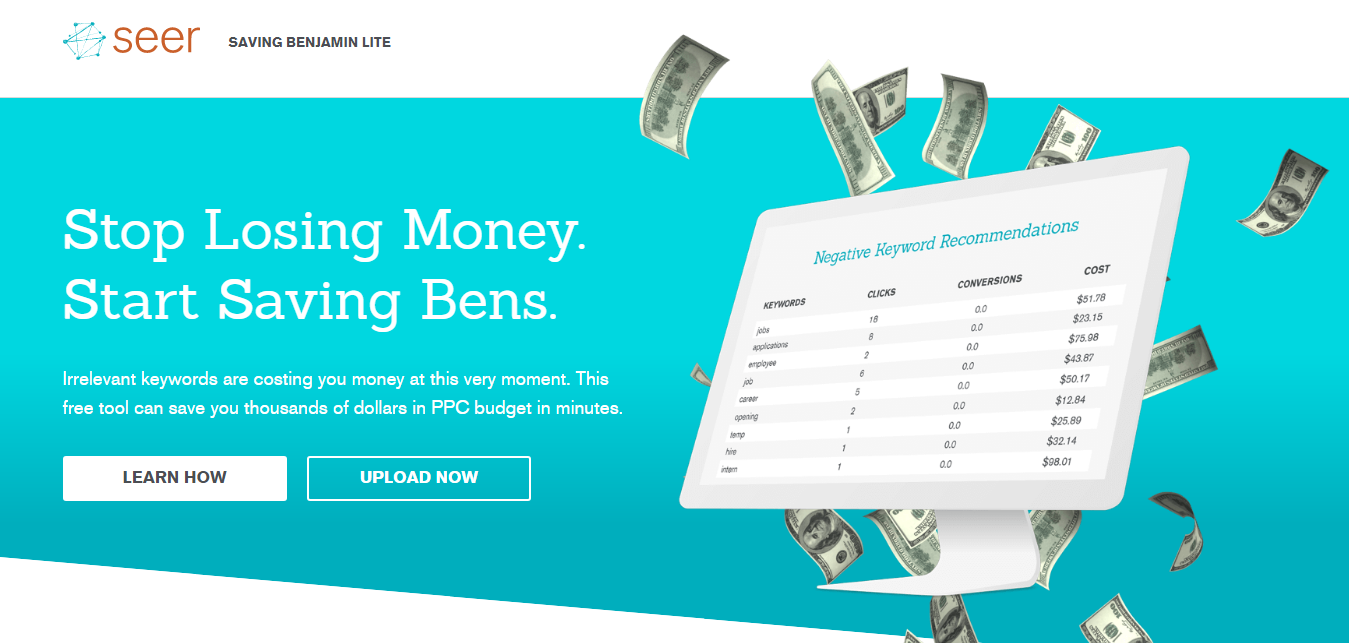The common wisdom around negative keywords is wrong. Search online for the “best way to find negative keywords”, and the advice you’ll find sounds something like this:
Open your Search Query Report, select any irrelevant search terms, and click “Add as Negative Keyword”.
Use your market knowledge and common sense.
Here are X commonly searched unwanted keywords, add them to your entire account as a negative keyword list and you’re covered.
The truth is, most of the time these methods aren’t enough to prevent wasting up to 15 percent of your account’s total budget. Irrelevant and unwanted search terms can creep into your search terms report in a number of ways:
- By using broader match types that target long-tail keywords
- When ads appear for searches containing close variant keywords even affect exact match keywords
- When Google’s smart features are utilized and the underlying AI fails to detect a mismatch between a searcher’s intent and your ad
Counterintuitively, the most sophisticated account strategies that leverage Google’s AI, take into account close variants as they’re currently applied, and go after long-tail keywords that generate conversions, often result in less control over the searches for which an ad can appear.
Best practices dictate that you should add negative keywords to your account on an ongoing basis, however, research has shown that almost half of all advertisers don’t add a single negative keyword to their account during any given month.
Why are advertisers skipping such a fundamental component of account management?
This can be better understood by examining the common advice for executing a negative keyword strategy. Upon inspection, the familiar recommendations for performing this task fall prey to at least one of three major fallacies.
Negative Keyword Fallacy #1:
Use “Common Sense” and Gut Instincts to Inform Your Negative Keyword Strategy
“Brainstorm the types of businesses, products, or services that yours could be mistaken for and the search terms which would be used to describe them.” Search Engine Watch
“You might already have an idea of the search queries that you don’t want to trigger your ads. This may include terms like ‘cheap’ or ‘free’.” WordTracker
“For example, a retailer who sells men’s work boots may want to add negative keywords for search terms like “rain boots” and “cowboy boots” to avoid attracting an irrelevant “boots” audience.” Instapage
The common thread in all of this advice is the idea that a decision about which negative keywords to use can be based on assumptions, guesses, gut feelings, and intuition. At Seer, we're committed to stopping guessing. That means that every question opens a data set rather than making leaps of faith to base an answer on assumptions or intuition.
When decisions are based on data, it becomes obvious how unlikely it would be to predict or guess the negative keywords identified through data analysis that saves our clients thousands of dollars a year.
For example, take the time we found out searches for 21 Savage’s song, “Bank Account” were triggering ads for businesses in the financial industry. The notion that the phrase “21 Savage” or the word “rap” would have been predicted in advance as negative keywords for a banking client is an unlikely scenario. But because our negative keyword strategy was grounded in data, we caught the inefficiency in the search terms report and saved our client $60K+.
Consider how the recent surge in searches related to coronavirus may be impacting paid search terms. For a bank, investigating the actual search terms users are logging before adding negative keywords could mean the difference between negating every search containing the word “coronavirus”, versus negating many searches containing “coronavirus” and gaining impressions from users who are searching for “banks open during coronavirus”.
Negative Keyword Fallacy #2:
You Can Realistically Mine Your Search Terms Manually to Select Negative Keywords
The instructions from Google below for adding negative keywords to an account have been echoed far and wide. They instruct practitioners to mine search terms for negative keywords manually, one by one, to make sure ads aren’t appearing for unwanted searches.
Instructions
- Sign in to your Google Ads account.
- From the page menu on the left, click Keywords.
- To see search terms for all keywords, click Search terms at the top. To see search terms for only a select group of keywords, check the boxes next to the keywords you’d like to see search terms for. Then click Search terms in the menu that appears above the table.
- Check the boxes next to the search terms that you'd like to add as negative keywords, then click Add as a negative keyword.
As long as you have the time, stamina, and faculties it would take to evaluate every single keyword in your search terms report line by line, there’s actually nothing wrong with these instructions. The search terms report provides a wealth of information that can help determine whether or not to negate a keyword. The problem is that, unless the account is extremely limited in scope and budget, the time required to do this adequately within the platform could be better spent elsewhere.
At Seer, a typical Google Ads account gains impressions and clicks for thousands of search terms every single day. We prefer to invest our time and resources into playing with scripts, investigating automated solutions and identifying market opportunities, rather than individually auditing that many search terms a day for relevancy.
When we do audit search terms for negative keyword opportunities we look for trends across multiple search terms, rather than negating one exact match search term at a time, to prevent unprofitable root terms from reappearing over and over again.
Negative Keyword Fallacy #3:
You Can Save Time by Relying on 'Set It & Forget It' Universal Lists
The concept of a “universal” negative keyword list is based on the idea that there are keywords that should be negated across all accounts regardless of industry and goals. This idea assumes that search behavior is static, some keywords are inherently unprofitable, and that what works on one account will necessarily work on another account.
Adding negative keywords generated from a one-size-fits-all list, much less adding them in bulk, leaves your account vulnerable to seismic and unknowable effects. Consider how little visibility is provided by Google into the impact of adding just one negative keyword, such as exactly which searches you’re opting out of and the number impressions being siphoned off. Multiply that impact by the number of keywords added all at once with a universal list, and the ability to understand how an account is being shaped by the invisible hand of its negative keywords becomes severely diminished.
Universal negative keyword lists, even those tailored to specific industries, perpetuate the set-it-and-forget-it mentality of practitioners who aren’t regularly mining search terms for negative keywords. One size doesn’t fit all, and while negative keyword lists can be used intelligently, they can’t effectively replicate the results of an ongoing, data-driven negative keyword strategy.
Hallmarks of a Data-Driven Negative Keyword Strategy
#1 Mine Data (All the Data!) to Negate Keywords at Scale
Intelligent negative keyword selection is grounded in data. Make decisions about which keywords to negate based on the data, all the data.
The Search Terms Report exposes performance data that can be used to inform negative keyword selection, and it acts as a record to better understand the impact of a negative keyword mined from it.
But don’t stop there.
Use any other data you have at your disposal, like your organic search data and your competitors’ organic search data. Join multiple data sources together to intelligently weed out keywords that are dragging down ROI. Look for trends across multiple search terms, rather than negating one exact match search term at a time, to prevent unprofitable root terms from reappearing over and over again.
#2 Limit Your Predictions -- Let the Data Speak for Itself
Don’t negate keywords based on your gut or on intuition. Every time you guess, you bring bias and risk to your conclusions.
Recognize that there can be unintended consequences of negating a keyword because it is intuited or assumed to be unprofitable, and be cognizant of how the effects of negative keywords can be challenging to detect because the future search terms being negated are not directly displayed in the Google Ads platform.
#3 Mine Search Terms Frequently -- Inefficiencies Hide in Positive ROI
Don’t set it and forget it. Just because an account is profitable and hitting its KPI goals doesn’t mean there aren’t underlying inefficiencies.
Make mining search terms for negatives a regular part of account maintenance, regardless of the account’s performance. At Seer, we mine our clients’ search terms every 24 hours using our proprietary PPC Efficiency Audit tool, and through that exercise, we’ve uncovered numerous examples of irrelevant keywords popping up in reports that would have never been signaled by the account’s performance.
Be curious about changes to the search landscape that could affect an account; investigate how news, events, pop culture, and anything else that could shape search behavior might impact your search terms.
Check out our free Saving Benjamin tool to start uncovering these keywords at scale yourself.
The Profitability of Your Paid Search Account Depends on Its Negative Keyword Strategy
The benefits of negating irrelevant keywords from an account may seem obvious-- saving money on wasted ad spend-- but they go much deeper. Avoid falling for common pitfalls, and your data-driven negative keyword strategy can become the unsung hero of your entire account.
An airtight negative keyword strategy enables a longer tail keyword strategy by mitigating the risks of targeting broader match types. There’s a reason long-tail keywords get so much attention in SEM; we found that average conversion rates for long-tail keywords were 4.15% higher than conversion rates for short-tail keywords.
A negative keyword strategy that detects and removes irrelevant keywords from search terms as soon as they’re shown to be unprofitable greases the wheels for a broader match keyword strategy that exploits long-tail searches.
While preventing wasted ad spend will obviously improve cost per conversion, even zero-click impressions for irrelevant searches that don’t impact your budget can affect your click-through-rate. Removing those unwanted impressions improves CTR, which is a factor in determining Quality Score. Higher quality scores mean lower costs per click, and this translates into more clicks and more conversions without ever changing your budget.
Interested in Having Seer Audit Your Search Terms for Negatives?
PPC Efficiency Audits take the guesswork out of negative keywords. Learn more about how these strategies can be applied to your account here.
Sign up for our newsletter for more posts like this - delivered straight to your inbox!




